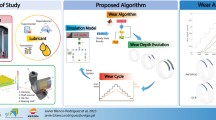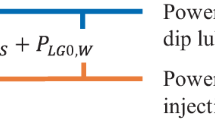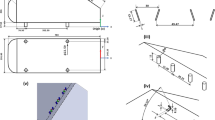Abstract
This paper puts forward a transient numerical model for thermoacoustic energy convertors using Rott’s equations combined with electrical circuit analogy. To enhance the accuracy of model outcomes, the lumped element values are updated at each time step as a function of temperature. Accordingly, a nonlinear temperature distribution is obtained along the hot core. The developed numerical approach is in line with the experimental results of a standing wave thermoacoustic engine. Based on this method, the temperature variations along the stack and the impact of stack material on start-up time and onset temperature are numerically investigated. Additionally, the onset temperature profiles are calculated and presented comparatively for the numerical and experimental results. The start-up time of spontaneous oscillations is calculated for the standing wave system. Consequently, the best geometry that quickly reaches sustained oscillations can be selected using this model. Examining the temperature profile during the start-up and damping process highlights a temperature difference between these two processes. This is calculated as 35 K in the numerical solution and measured as 38 K in the experiment for a standing wave engine. Observations show that using a material with lower thermal conductivity in the stack section can reduce the onset-damping temperature difference. The novel approach described here shows potential in capturing the onset-damping behavior of thermoacoustic systems efficiently.



















Similar content being viewed by others
Abbreviations
- A :
-
Area, m2
- Cp :
-
Specific isobaric heat capacity, J/K.mol
- E :
-
Acoustic power, W
- F(x) :
-
Energy flow, W
- f :
-
Spatially averaged thermoviscous function
- G(x) :
-
Thermoacoustic pumping effect, W
- g :
-
Controlled source coefficient
- Im[] :
-
Imagine part of parameter
- k :
-
Thermal conductivity coefficient, W/m2K
- p :
-
Amplitude of oscillating pressure, Pa
- P :
-
Mean pressure, Pa
- Q :
-
Heat power, W
- R :
-
Universal gas constant, J/K.mol
- Re[] :
-
Real part of parameter
- T :
-
Temperature, K
- U :
-
Amplitude of oscillating volume flow rate, m3/s
- V :
-
Volume, m3
- DR:
-
Drive ratio
- γ :
-
Ratio of specific heat
- ρ :
-
Average density of gas, kg/m3
- δ :
-
Viscous penetration depth, m
- σ :
-
Prandtl number
- ω :
-
Rotational frequency, rad
- μ :
-
Dynamic viscosity, kg. s/m
- a :
-
Ambient
- in :
-
Input
- i :
-
Spatial discretization node numerator
- out :
-
Output
- v :
-
Viscous
- κ :
-
Thermal
- p :
-
Isobaric
- gas :
-
Related to the gas
- solid :
-
Related to the solid media
- m :
-
Mean
- norm:
-
Normalized parameter
- o :
-
Onset period
- d :
-
Damping period
- e :
-
Error
- ~:
-
Complex conjugate
- n :
-
Time step
References
Zare S, Tavakolpour-Saleh AR (2020) Free piston Stirling engines: A review. Int J Energy Res 44(7):5039–5070. https://doi.org/10.1002/er.4533
Sarkar J, Bhattacharyya S (2012) Application of graphene and graphene-based materials in clean energy-related devices Minghui. Arch Thermodyn 33(4):23–40
Hasegawa S, Yamaguchi T, Oshinoya Y (2013) A thermoacoustic refrigerator driven by a low temperature-differential, high-efficiency multistage thermoacoustic engine. Appl Therm Eng 58(1–2):394–399. https://doi.org/10.1016/j.applthermaleng.2013.04.030
Sharify EM, Hasegawa S (2017) Traveling-wave thermoacoustic refrigerator driven by a multistage traveling-wave thermoacoustic engine. Appl Therm Eng 113:791–795. https://doi.org/10.1016/j.applthermaleng.2016.11.021
Wang K et al (2016) Acoustic matching of a traveling-wave thermoacoustic electric generator. Appl Therm Eng 102:272–282. https://doi.org/10.1016/j.applthermaleng.2016.03.106
Chen G, Krishan G, Yang Y, Tang L, Mace B (2020) Numerical investigation of synthetic jets driven by thermoacoustic standing waves. Int J Heat Mass Transf 146:118859. https://doi.org/10.1016/j.ijheatmasstransfer.2019.118859
Bou Nader W, Chamoun J, Dumand C (2020) Thermoacoustic engine as waste heat recovery system on extended range hybrid electric vehicles. Energy Convers Manag 215:112912. https://doi.org/10.1016/j.enconman.2020.112912
Bahrami M, Ommi F (2021) Developing an augmented onset model for a thermoacoustically-driven, pulse tube cryocooler. Sustain Energy Technol Assess 47:101402. https://doi.org/10.1016/j.seta.2021.101402
Qiu L, Chen G, Jiang N (2002) Optimum packing factor of the stack in a standing-wave thermoacoustic prime mover. Int J Energy Res 26(8):729–735. https://doi.org/10.1002/er.800
Jin T, Yang R, Liu Y, Tang K (2016) Thermodynamic characteristics during the onset and damping processes in a looped thermoacoustic prime mover. Appl Therm Eng 100:1169–1172. https://doi.org/10.1016/j.applthermaleng.2016.02.115
Tan J, Wei J, Jin T (2019) Onset and damping characteristics of a closed two-phase thermoacoustic engine. Appl Therm Eng 160:114086. https://doi.org/10.1016/j.applthermaleng.2019.114086
He YL, Ke HB, Cui FQ, Tao WQ (2013) Explanations on the onset and damping behaviors in a standing-wave thermoacoustic engine. Appl Therm Eng 58(1–2):298–304. https://doi.org/10.1016/j.applthermaleng.2013.04.031
Bahrami M, Ommi F (2022) Performance of a multi-stage thermoacoustically-driven pulse tube cryocooler: Uncertainty quantification and sensitivity analysis. Appl Therm Eng 200:117653. https://doi.org/10.1016/j.applthermaleng.2021.117653
Yahya SG, Mao X, Jaworski AJ (2017) Experimental investigation of thermal performance of random stack materials for use in standing wave thermoacoustic refrigerators Étude expérimentale de la performance thermique de stacks en matériaux aléatoires utilisés dans des réfrigérateurs thermoacou. Int J Refrig 75:52–63. https://doi.org/10.1016/j.ijrefrig.2017.01.013
Shen C, Li HX, Zhang DW, Yu P, Pan N, Wang SF (2016) Study on the heat transfer characteristic of solar powered thermoacoustic prime mover at different tilted angles. Appl Therm Eng 103:1126–1134. https://doi.org/10.1016/j.applthermaleng.2016.04.096
Shen C, He Y, Li Y, Ke H, Zhang D, Liu Y (2009) Performance of solar powered thermoacoustic engine at different tilted angles. Appl Therm Eng 29(13):2745–2756. https://doi.org/10.1016/j.applthermaleng.2009.01.008
Chen G, Tang L, Mace BR (2018) Theoretical and experimental investigation of the dynamic behaviour of a standing-wave thermoacoustic engine with various boundary conditions. Int J Heat Mass Transf 123:367–381. https://doi.org/10.1016/j.ijheatmasstransfer.2018.02.121
Zorgnotti V, Penelet G, Poignand G, Garrett SL (2018) Prediction of limit cycle amplitudes in thermoacoustic engines by means of impedance measurements. J Appl Phys 124(15):154901. https://doi.org/10.1063/1.5040906
Qiu LM et al (2013) Characteristics of onset and damping in a standing-wave thermoacoustic engine driven by liquid nitrogen. Chinese Sci Bull 58(11):1325–1330. https://doi.org/10.1007/s11434-012-5214-z
Chen G, Tang L, Mace BR (2019) Modelling and analysis of a thermoacoustic-piezoelectric energy harvester. Appl Therm Eng 150:532–544. https://doi.org/10.1016/j.applthermaleng.2019.01.025
Kuzuu K, Hasegawa S (2021) Numerical investigation of a thermoacoustic engine core via heat transfer calculations coupled with acoustic field analyses. Appl Therm Eng 183:116223. https://doi.org/10.1016/j.applthermaleng.2020.116223
Guédra M, Bannwart FC, Penelet G, Lotton P (2015) Parameter estimation for the characterization of thermoacoustic stacks and regenerators. Appl Therm Eng 80:229–237. https://doi.org/10.1016/j.applthermaleng.2015.01.058
Swift GW (2017) Thermoacoustics. Springer International Publishing, Cham
Wang K et al (2015) Numerical simulation on onset characteristics of traveling-wave thermoacoustic engines based on a time-domain network model. Int J Therm Sci 94:61–71. https://doi.org/10.1016/j.ijthermalsci.2015.02.010
Xiao JH (1995) Thermoacoustic heat transportation and energy transformation Part 1: Formulation of the problem. Cryogenics (Guildf) 35(1):15–19. https://doi.org/10.1016/0011-2275(95)90419-G
Piccolo A, Pistone G (2006) Estimation of heat transfer coefficients in oscillating flows: The thermoacoustic case. Int J Heat Mass Transf 49(9–10):1631–1642. https://doi.org/10.1016/j.ijheatmasstransfer.2005.11.009
Marx D, Blanc-benon P (2005) Numerical calculation of the temperature difference between the extremities of a thermoacoustic stack plate. Cryogenics 45:163–172. https://doi.org/10.1016/j.cryogenics.2004.08.007
Nouh M, Aldraihem O, Baz A (2014) Transient characteristics and stability analysis of standing wave thermoacoustic-piezoelectric harvesters. J Acoust Soc Am 135(2):669–678. https://doi.org/10.1121/1.4861236
Guan Y, He W, Murugesan M, Li Q, Liu P, Li LKB (2019) Control of self-excited thermoacoustic oscillations using transient forcing, hysteresis and mode switching. Combust Flame 202:262–275. https://doi.org/10.1016/j.combustflame.2019.01.013
Li X, Zhao D, Li X (2018) Effects of background noises on nonlinear dynamics of a modelled thermoacoustic combustor. J Acoust Soc Am 143(1):60–70. https://doi.org/10.1121/1.5020059
Funding
The authors declare that no funds, grants, or other support were received during the preparation of this manuscript.
Author information
Authors and Affiliations
Contributions
All authors contributed to the study conception and design. Material preparation, data collection and analysis were performed by Alireza Moradi and Mohsen Bahrami under the supervision of Fathollah Ommi and Zoheir Saboohi.
Corresponding author
Ethics declarations
Competing interests
The authors have no relevant financial or non-financial interests to disclose.
Additional information
Publisher's Note
Springer Nature remains neutral with regard to jurisdictional claims in published maps and institutional affiliations.
Alireza Moradi and Mohsen Bahrami contributed equally to this work and should be considered co-first author.
Rights and permissions
About this article
Cite this article
Moradi, A., Bahrami, M., Ommi, F. et al. Start-up and damping of a standing wave thermoacoustic engine: model development and experimental evaluation. Heat Mass Transfer 58, 2175–2193 (2022). https://doi.org/10.1007/s00231-022-03235-w
Received:
Accepted:
Published:
Issue Date:
DOI: https://doi.org/10.1007/s00231-022-03235-w




